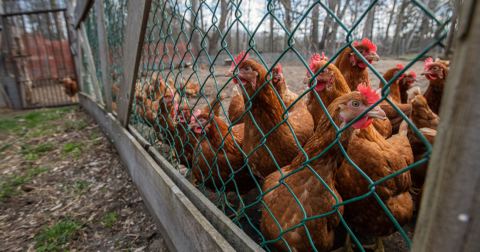Feature
How Much Meat Can You Eat and Still Be ‘Climate-Friendly?’
Research•9 min read
Reported
A new study published in Nature finds genetic changes are making recent outbreaks of avian flu more severe in mammals.


Words by Jennifer Mishler
A new study published in Nature Communications concludes that genetic changes are making recent outbreaks of avian flu more severe in mammals. The scientists behind the research warn the disease now poses a bigger risk to humans. While avian influenza has been spreading at historic rates in farmed and wild bird populations since 2021, viruses change over time, and the danger this disease poses to many other species could continue to increase.
“This is not just a chicken virus now,” says lead author Dr. Richard Webby, who studies infectious disease at St. Jude Children’s Research Hospital, and influenza in animals and birds at the World Health Organization. “It’s also infecting other avian and mammal species in the U.S. It’s a higher exposure risk for humans and other mammals than we’ve ever had in North America. We’ve never really been exposed to this level of circulation of these highly pathogenic flu viruses.”
So, exactly how worried should we be that gene mutations of avian flu will cause the next human global pandemic? Let’s take a look.
The scientists behind the new study found that as H5N1 avian flu spread in North America, the virus became able to “severely infect” mammalian brains, marking “a notable departure from previous related strains of the virus.”
Researchers were surprised at the virus loads found in the brains of ferrets, which were purposefully infected as part of the study. Some became very ill, experiencing “rapid weight loss, lethargy, and severe neurologic symptoms, including ataxia [loss of muscle control and coordination] and hindlimb paralysis.”
“That’s not the first time we’ve seen H5 viruses in the brain, but these are probably some of the most virulent we’ve looked at over 24 years of following these viruses,” says Webby.
While in the past, other influenza capable of resulting in severe disease have not spread beyond the initial bird populations impacted, this strain has spread significantly in farmed chicken flocks before infecting other species, St. Jude’s research finds.
Avian flu has already infected humans, including in the United States. According to the WHO, there have been six confirmed cases around the world since 2020.
While the WHO encourages strict surveillance for any potential animal-to-human spread, the UN agency also emphasizes that all six cases thus far have resulted from close contact with birds, with some individuals either managing outbreaks or working with poultry.
Health agencies maintain the threat posed by avian flu to humans remains very low. Webby concurs, but warns that this may not always be the case, as the virus is changing. He also points out that we should not only consider human risk of transmission, but how bad the illness may be once contracted.
“Someone would have to work pretty hard to infect themselves with this virus,” says Webby. “But if they do happen to be infected, there’s a real chance of getting a severe disease from it.”
The latest identified human case of H5N1 was reported in Chile in late March, when a 53-year-old man was “hospitalized with severe illness,” according to the CDC.
In the U.S. alone, nearly 60 million farmed birds have been culled or died due to the spread of avian flu, and over 6,900 wild birds have been impacted. Nearly all U.S. states — 47 in total — have reported experiencing outbreaks in their poultry flocks.
Egg producers say avian flu is behind rising prices, and most recently, Hormel named the resulting disruptions in its supply chain as the cause of declining turkey meat sales.
According to a recent report from the World Organization for Animal Health, 1.5 million poultry were killed or died in just the three-week period between March 30 and April 20, 2023. The report concludes that although the disease’s spread may have already peaked in many places, avian flu is now affecting wild birds in new areas of the world, including Gambia. In May, top poultry exporter Brazil declared a 180-day state of emergency amid cases found in wild populations.
Some countries, including Mexico and China , have already begun inoculating poultry flocks against avian flu, while others such as the U.S. are testing vaccines . Following the deaths of 21 California condors, the USDA authorized the emergency use of a vaccine in this critically endangered wild species.
The consensus among health agencies seems to be that overall, avian flu poses a relatively low risk to human public health at this time, but that officials must remain vigilant.
“We have already witnessed in recent years an unprecedented number of deaths in wild birds, and outbreaks in domestic birds in many countries,” writes the WHO. H5N1’s spread from avian species to mammals and outbreaks on Spanish mink farms “underline the unpredictable nature of the disease and its potential risk to human health.”
So what can consumers do to stem the spread of avian flu? Of course, it would be wise to avoid handling wild birds or poultry. Abstaining from eating poultry and supporting the industrial farming system that drives avian flu’s spread is also a way not to contribute to the virus’s continuing mutation. While heat from cooking kills avian flu, handling or consuming raw poultry is not without health risks. If you’re worried about supporting the spread and mutation of avian flu, consider buying a plant-based chicken option instead.